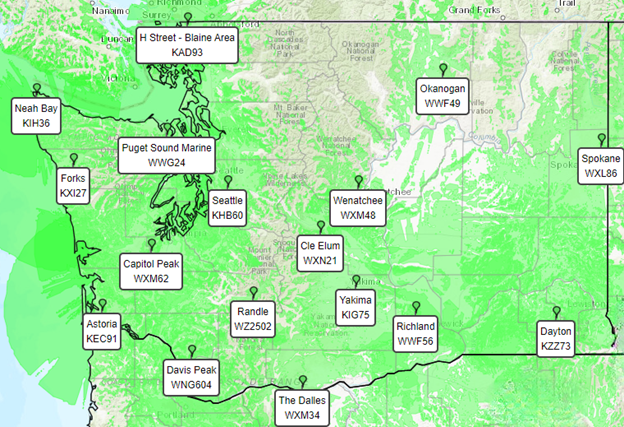Cantwell Bills to Modernize Nation’s Weather Radio, Deliver Real-Time Emergency Alerts Pass Senate
Bills would upgrade U.S. weather radio stations -- including 17 across WA -- and expand coverage in rural areas; In 2023, the U.S. experienced 25 weather and climate-related disasters exceeding $1B dollars in damages each & resulting in nearly 500 deaths
WASHINGTON, D.C. – Yesterday, the Senate unanimously passed the National Oceanic and Atmospheric Administration (NOAA) Weather Radio Modernization Act and the National Weather Service Communications Improvement Act, bipartisan bills aimed at modernizing the nation’s weather communication and radio service as the country faces more frequent and intense weather events.
U.S. Senator Maria Cantwell (D-WA), Chair of the Senate Committee on Commerce, Science, and Transportation, introduced both bills. They passed the Committee in May 2023 and now head to the House of Representatives.
“Gaps in weather radio coverage keep communities in the dark about incoming weather hazards, that’s why I’m proud that these two bipartisan bills that passed the Senate would finally upgrade the National Weather Service warning technology, expand radio alert coverage in rural and tribal communities, and repair weather radio stations across the country, including 17 stations in the State of Washington,” said Sen. Cantwell. “The threat from weather events is only increasing, especially with El Nino bringing atmospheric rivers and winter storms this season, so access to reliable, real-time alerts are more important than ever to keep their families safe and homes secure. It’s critical that we modernize our outdated technology, and I will keep working to get these important bills signed into law.”
The NOAA Weather Radio Modernization Act would:
- Require upgrades to outdated weather radio technology to provide reliable and continuous weather and emergency alerts.
- Expand radio coverage to rural areas that do not currently have access to the National Weather Radio alert system.
- Increase National Weather Radio coverage to reach 98-99% of the United States population.
- Update National Weather Radio infrastructure and reduce reliance on copper wire transmissions – which are increasingly unreliable because copper is impacted by extreme temperature changes and severe weather.
The National Weather Service Communications Improvement Act would:
- Improve the National Weather Service’s internal instant messaging system.
- Implement a modern cloud system to accommodate more users and faster service.
In 2023, the United States has experienced 25 weather and climate-related disaster events to date that exceeded $1 billion in damages each, resulting in nearly 500 deaths. In recent years, the State of Washington has experienced several extreme weather events, including the 2021 heat dome, which brought record-breaking temperatures across the state and according to a new report from the University of Washington resulted in more than 400 deaths. Later that year, Northwest Washington experienced historic flooding, damaging over 2,000 homes and businesses in Sumas. In 2023, 1,884 wildfires burned more than 165,365 acres across the state. Last October, smoke from wildfires in the Cascades caused Seattle to have the worst air quality of any city on Earth.
There are currently 17 National Weather Radio transmitters in Washington state. Each transmitter location, call sign, and coverage range is displayed below.

(Map attributed to the NOAA National Weather Service – available HERE)
Sen. Cantwell authored $3.3 billion in NOAA investments in the Inflation Reduction Act to help communities prepare for and adapt to climate change, boost science needed to understand changing weather and climate patterns, and invest in advanced computer technologies that are critical for extreme weather prediction and emergency response. In 2022, Sen. Cantwell introduced the Fire Ready Nation Act to establish a fire weather services program within NOAA – authorizing engagement in wildfire response activities, and providing funding for science and technologies to forecast weather conditions that cause and spread wildfires, as well as weather products needed on the ground to inform and protect first responders during a fire. The bill was passed by the Committee in May 2022.
NOAA’s National Weather Service operates a nationwide network of public radio stations that broadcast weather warnings, forecasts, and emergency information 24/7. NOAA Weather Radio includes more than 1,000 transmitters, covering all 50 states, adjacent coastal waters, Puerto Rico, the U.S. Virgin Islands, and the U.S. Pacific Territories. Broadcasts include warnings, watches, and forecasts for natural disasters like storms, fire, earthquakes, avalanches, and even environmental hazards such as chemical or oil spills. According to NOAA, more than 400 National Weather Service transmitters will need to be replaced in the next five years.
The full bill text of the NOAA Weather Radio Modernization Act is available HERE.
The full bill text of the National Weather Service Communications Improvement Act is available HERE.
###
Next Article Previous Article